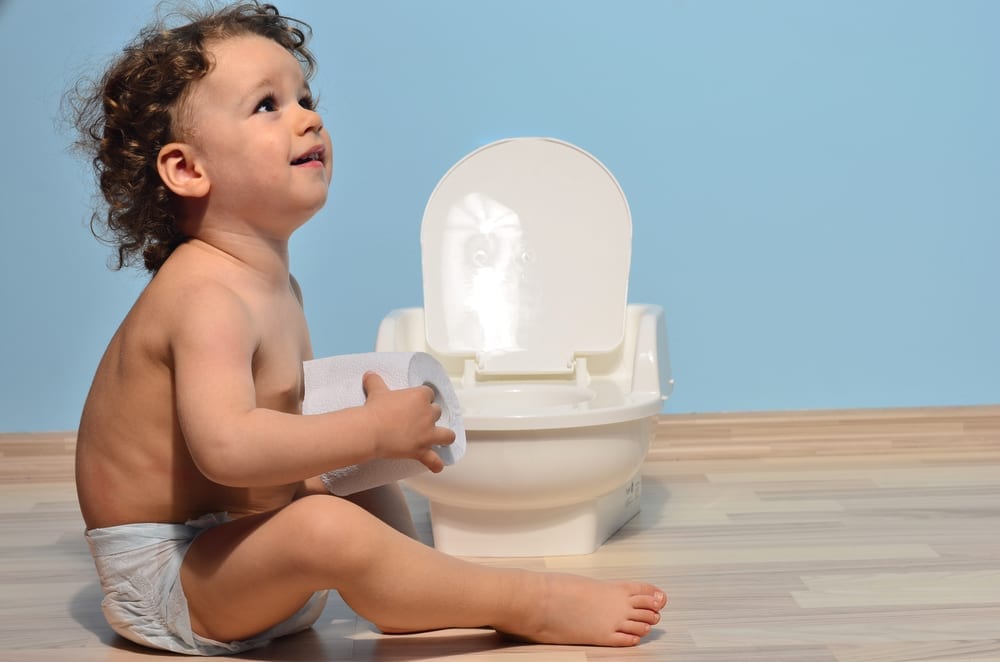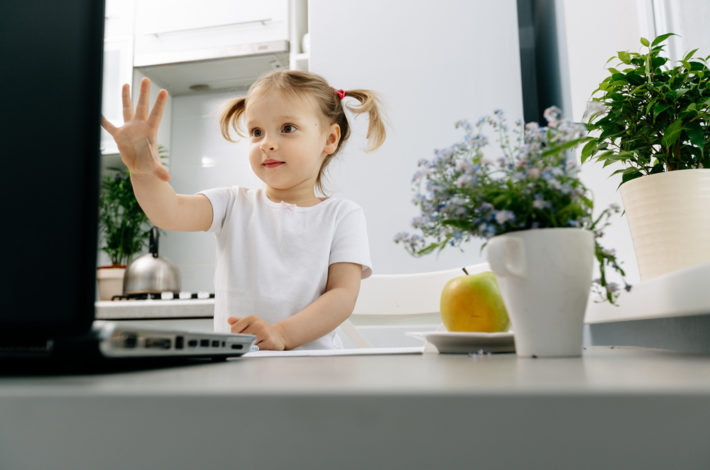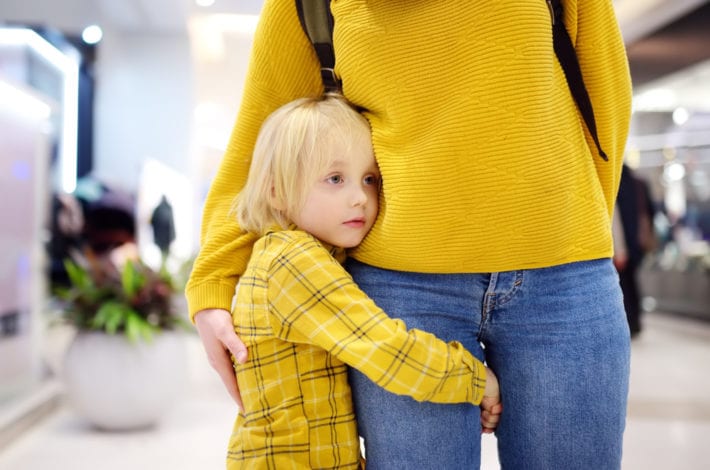Potty training a toddler is something every parent has to go through. For some it’s all plain sailing. For others it’s a bit of a struggle. Especially when it comes to number 2’s.
If your toddler happily wees in the potty but is reluctant (or even scared) to poop – don’t panic. It’s very common and there are lots of things you can do to help.
Is my child the only one who refuses to poop in the potty?
There’s plenty of anecdotal evidence in parenting forums to reveal how common it is for toddlers to refuse to poop on the potty.
Many parents share stories of how their toddler will happily wee on the potty but just won’t poop. They say that their child holds in their poo until the moment their night time nappy or pull ups go on. Then they hide behind the sofa or in the corner of a room to let it go. Sound familiar?
If so, rest assured, you’re not the first parent to face this problem. And you certainly won’t be the last.
Why does my toddler refuse to poop on the potty?
There can be a number of reasons why your child refuses to poo on the potty. Some are easier to fix than others.
They’re not ready yet
Your toddler might not be quite ready yet for potty training. There’s no ideal age for toilet training, every child is ready in their own time.
Waiting a while and trying again a little later might be what makes a difference. When you do try again, you may well find that they’re ready and it’s all much easier.
Too busy having fun?
The cause could be as simple as them having too much fun to sit down for a little while to do their business.
You might ask your toddler to sit on the potty but they could be too busy or too mentally focused on a toy or game. So they don’t have the time or patience to sit down and let it come out.
Even if they do sit down for a few minutes, sometimes their minds are distracted and they’re anxious to get back to whatever they were doing before.
They’re scared of it
Often the number one reason your toddler refuses to poop in the potty (or the loo) is fear.
Toddlers can become so used to the comfort of nappies that exposing their bottoms to sit on the potty can feel weird – and cold.
Your toddler might be frightened about the air they feel on their bottom or, if they’re on the loo, about water splashing up to touch their skin.
They might be worried about letting something (that they see as a part of them) fall out of their bottom. They might even have an irrational fear of being sucked down the toilet.
When they get these worries in their heads they might decide that sticking to nappies is by far the safest option.
So, what can you do when your toddler is afraid to poop in the potty?
There are plenty of things you can do to help your child move from pooping in a nappy to using the potty or toilet.
It will, however, take time, as much positivity as you can muster and a whole lotta patience.
Disclosure: contains some affiliate links
Go potty about potty books
Read lots of books about using the potty or the loo to your child. Not necessarily when they’re on the potty but when they’re relaxed and curled up on the sofa or in bed with you.
Look for those that handle the topic in a kid friendly, gentle and humorous way. You may be surprised at how quickly your child wants to join in. We love these books:

 Potty, Leslie Patricelli (Amazon): https://amzn.to/2BWGqy7
Potty, Leslie Patricelli (Amazon): https://amzn.to/2BWGqy7

 Princess Polly’s Potty (Amazon): https://amzn.to/2Wtdyqs
Princess Polly’s Potty (Amazon): https://amzn.to/2Wtdyqs

 Pirate Pete’s Potty (Amazon): https://amzn.to/2BTrwc1
Pirate Pete’s Potty (Amazon): https://amzn.to/2BTrwc1

 Ninja Potty Break (Amazon): https://amzn.to/2Wp87cm
Ninja Potty Break (Amazon): https://amzn.to/2Wp87cm
Let them poo in their nappies
If your toddler insists on wearing a nappy to poo then let them.
It feels like you are giving up before you’ve even started your journey. But if you say no they might hold in their poos and become constipated – and this makes the whole issue much worse.
The best thing to do is to let them have a nappy on whenever they need to poop and gradually work on changing their behaviour.
Wave bye bye to the number 2s
Immediately after your toddler has done their business, take off their nappy and take your child with you to the bathroom.
Show them how you’re putting it into the toilet and let them watch you do it. Remind them that ‘this is where poop goes’.
You can then both wave bye bye before flushing it away.
Small steps from nappy to potty
When you put a nappy on your child, you will probably notice that they have a favourite place to go and poo. They might stand behind the sofa, for example.
You want to put lots of small achievable steps in place to move them from pooping in their nappy in their preferred place to pooping in the potty or the loo. These steps might look like this:
- Move the preferred place to the bathroom. Keep a close eye on them and when they go to their favourite place, gently encourage them to go the bathroom instead. You might need to pick them up and carry them there. They can still poop in their nappy but they must do it standing in the bathroom.
- Sit on the potty. After a week or so let them still wear their nappy but sit on the potty or on a potty seat on the toilet to do their poo.
- Do the nappy hole trick. Next cut a hole in the nappy before putting it on your child. Let them wear it as they sit on the potty. It sounds a little strange but it gives your toddler the security of feeling the nappy while also letting the poo fall into the potty.
- Take the plunge. Once your child has got the hang of that, it’s time to try pooping on the potty without a nappy.
Remember to give heaps of praise each step along the way.
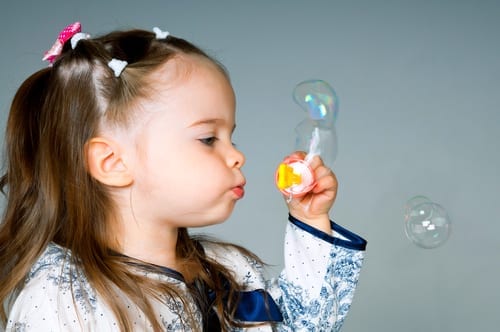
Blowing bubbles isn’t just for fun
A child who has refused to poop on the potty and is anxious about it, might find it hard, at first, to relax their muscles enough to let the poo come out. They might need to sit for 5 or 10 minutes waiting for this to happen.
As they sit it helps to distract them with toys or by reading a story. The number one weapon in your potty training armoury might be – surprisingly – a bottle of bubbles.
Blowing bubbles uses the same muscles your child needs to relax to poop. And playing with bubbles is great fun too. Keep tubs of bubbles by the potty or loo and only use them for potty time.
Try it backwards
Some kids find it easier to sit backwards on the potty. Holding onto the back of the potty makes them feel more secure and suddenly the potty seems less scary.
It doesn’t work with all children, but it’s worth trying in case this does make the difference for you.
Take away any pressure
Try taking away all pressure to ‘perform’ and let sitting on the potty (or loo) be the only goal.
If they refuse to sit on the potty with their pants down, you could start with them full clothed.
Begin by letting them sit for a few seconds, and move towards a goal of sitting on the potty when you ask them to with their pants down, for 5-10 minutes while you chat, read or play with toys.
If you are able to, get your child to sit on the potty for 10-15 minutes after a meal, when there’s a greater chance that they will need to poop. Give hugs and praise for just sitting on the potty with no mention at all of weeing or pooing.
When all the pressure is removed and lots of clapping is given for just sitting on the potty, you can remove any fear or resistance and restart your potty training journey.
Give your toddler alone time on the potty
If you hover nearby you can inadvertently add to the pressure of having to poop. If your toddler has time to sit on the potty alone they might relax enough to let go.
Once they have become used to sitting happily on the potty, and if you sense that they would prefer to be alone, you can leave them and wait outside.
Give them a pile of books or a special basket of toys to go through while they wait.
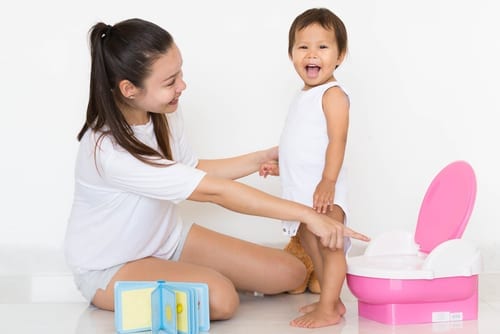


Go big on rewards
Take a large jar and fill it with little toys. Make this the ‘potty reward jar’ and place it in full view of the potty.
Your toddler can keep their eyes on the prize as they sit. Once they earn a reward it will make pooping on the potty a positive experience and motivate them to do it again.
You also don’t have to use toys. Toddlers love stickers and a reward chart on the wall works really well too.
You could also make up your very own potty song and dance every time they do a poo, to make them feel good and excited about this big milestone they’re overcoming.
Keep calm and carry on
It takes some children a lot longer than others to break the habit of pooping in their nappies and be brave enough to go in the potty or loo.
They might achieve one step but then refuse to move to the next. Or have accidents along the way.
If they do, try to stay calm. Keep letting your toddler poop in their nappy but remind them that they must let you know when they’re ready to try the next step.
Don’t punish or shame your child if they don’t poop in the potty. The calmer you can be, the less likely you are to make it into a power struggle.
Ignore any accidents or steps backwards and heap on the praise for any achievements. ‘Keep calm and keep trying’.
When it’s too sore to poop
If your child has been happily pooping on the potty but suddenly refuses it could be due to constipation. If your child becomes constipated they will often find it sore to poo.
Even one painful poop can be enough to scare your toddler from trying again.
Some toddlers will hold onto their poo and their stool then becomes bigger and harder and will be even sorer to push out.
When the need to go becomes too great a child might push out the tiniest amount of poo they can, smearing their pants, instead of emptying their bowels. And this can lead to a vicious cycle that’s hard to break.
If you think your child is constipated make sure they drink plenty of water and eat foods high in fibre, such as grains, fruit and veg. Prune juice can have a laxative effect and can be given to babies over 12 months to ease constipation.
It’s always best to check with your health visitor or G.P. first. You might also want to ask your doctor if he would recommend giving your child a stool softener or mild laxative to get things moving again.
It’s a golden rule to sort out any constipation before restarting any potty training. You might even want to go back to nappies or pull ups until your child is no longer constipated.
Once your child is pooping easily again, restart the steps you were following before to get them to poo on the potty.
If refusing to poo on the loo becomes a bigger problem
With a bit of encouragement, a lot of patience and heaps of praise, most children will overcome their refusal to poop in the potty or toilet.
Occasionally (although not commonly) it can become a real problem. If you’re reading this and your child is no longer a toddler but is older and still has a problem then there are resources that can help you.
ERIC (The Children’s Bowel and Bladder Charity) has lots of expert advice to help. They also share some case studies (including some concerning children with learning disabilities) detailing how parents finally overcame such problems. They are full of useful tips and inventive ideas to try.
No one walks down the aisle in nappies
Potty training is rarely a treasured part of parenting. Especially when it seems to be taking ages and your child keeps taking one step forward and then two back.
Cleaning up a seemingly never ending array of soiled pants and furniture is not anyone’s idea of fun. Neither is kneeling by your child in a cramped bathroom waiting for them to poop.
But don’t give up hope. Your child WILL poop in the potty. They might even do it today. Or next week. Or next month. And once they do, and realise it wasn’t such a big deal after all, you’ll be plain sailing.
Give them a huge hug for their achievement and give yourself a massive pat on the back too. If you made it through this potty training hurdle without going potty – you deserve it!

